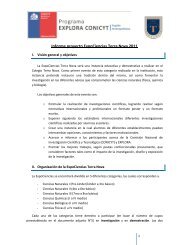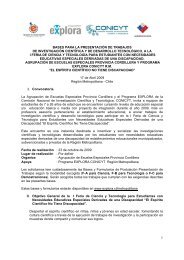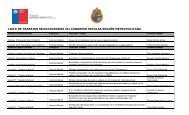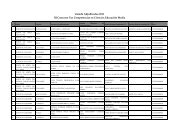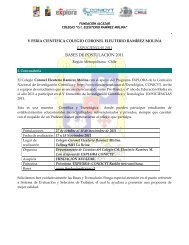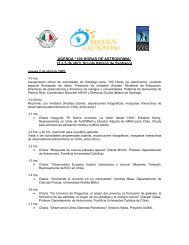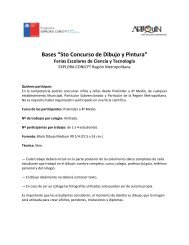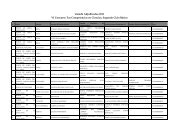Sobreviviendo a un tsunami - EXPLORA CONICYT RM
Sobreviviendo a un tsunami - EXPLORA CONICYT RM
Sobreviviendo a un tsunami - EXPLORA CONICYT RM
- No tags were found...
Create successful ePaper yourself
Turn your PDF publications into a flip-book with our unique Google optimized e-Paper software.
Griffin, Wallace, 1984, Crescent City’sdark disaster: Crescent City PrintingCo., 188 p.Japan Meteorological Agency, 1961, Thereport on the ts<strong>un</strong>ami of the Chileanearthquake, 1960: Technical Report ofthe Japan Meteorological Agency No.8, 389 p.Lachman, R., Tatsuoka, M., & Bonk, W.J.,1961, Human behavior during thets<strong>un</strong>ami of May 1960: Science, v. 133,p. 1405-1409.Lander, J.F., Lockridge, P.A., & Koauch,M.J., 1993, Ts<strong>un</strong>amis affecting thewest coast of the United States 1806-1992: National Oceanic and AtmosphericAdministration, NGDC Key toGeophysical Records DocumentationNo. 29, 242 pp.Lockridge, P.A., 1985, Ts<strong>un</strong>amis in Peru-Chile: National Oceanic and AtmosphericAdministration, World DataCenter A for Solid Earth Geophysics.Report SE-39, 97 pp.Lomnitz, C., 1970, Major earthquakes andts<strong>un</strong>amis in Chile during the period1535 to 1955: Geologische R<strong>un</strong>dschau,Bd. 59, p. 938-960.Plafker, G., & Savage, J.C., 1970, Mechanismof the Chilean earthquakes ofMay 21 and 22, 1960: GeologicalSociety of America Bulletin, v. 81, p.1001-1030.Saint-Amand, P., ed., 1963, Specialissue—oceanographic, geologic, andengineering studies of the Chileanearthquakes of May 1960: Bulletin ofthe Seismological Society of America,v. 53, no. 6, p. 1123-1436.Servicio Hidrográfico y Oceanográfico dela Armada de Chile, 2000, El maremotodel 22 de Mayo de 1960 en lascostas de Chile (2d ed.): Valparaíso,SHOA, 72 p.Shepard, F.P., MacDonald, G.A., & Cox,D.C., 1950, The ts<strong>un</strong>ami of April 1,1946: Scripps Institution of OceanographyBulletin, v. 5. p. 391-528.The Committee for Field Investigation ofthe Chilean Ts<strong>un</strong>ami of 1960, 1961,Report on the Chilean ts<strong>un</strong>ami of May24, 1960, as observed along the coastof Japan: Tokyo, Maruzen Co., Ltd.,397 p.Terremoto y ts<strong>un</strong>ami de Cascadia en 1700Atwater, B.F., and Hemphill-Haley, E.,1997, Recurrence Intervals for GreatEarthquakes of the Past 3,500 Years atNortheastern Willapa Bay, Washington:U.S. Geological Survey ProfessionalPaper 1576, 108 pp.Atwater, B.F., Yelin, T.S., Weaver, C.S., &Hendley, J.W. II, 1995. Averting surprisesin the Pacific Northwest: U.S.Geological Survey Fact Sheet 111-95,2 pp.Atwater, B.F., Musumi-Rokkaku, S.,Satake, K., Tsuji, Y., Ueda, K., andYamaguchi, D.K., 2005, The orphants<strong>un</strong>ami of 1700—Japanese clues to aparent earthquake in North America:U.S. Geological Survey ProfessionalPaper 1707, published jointly withUniversity of Washington Press, Seattle,133 p. [http://pubs.usgs.gov/pp/pp1707/].Clague, J.J., 1997, Evidence for large earthquakesat the Cascadia subductionzone: Reviews of Geophysics, v. 35, p.439-460.Satake, K., Shimazaki, K., Tsuji, Y., &Ueda, K., 1996, Time and size of agiant earthquake in Cascadia inferredfrom Japanese ts<strong>un</strong>ami record ofJanuary 1700: Nature, v. 379, p. 246-249.Satake, K., Wang, K., and Atwater, B.F.,2003, Fault slip and seismic momentof the 1700 Cascadia earthquakeinferred from Japanese ts<strong>un</strong>amidescriptions: Journal of GeophysicalResearch, v. 108, 2325, doi:10.1019/2003JB002521.Tsuji, Y., Ueda, K., and Satake, K., 1998,Japanese ts<strong>un</strong>ami records from theJanuary 1700 earthquake in the Cascadiasubduction zone: Zisin, v. 51, p.1-17 (en japonés con resumen, figurasy leyendas en inglés).Yamaguchi, D.K., Atwater, B.F., B<strong>un</strong>ker,D.E., Benson, B.E., & Reid, M.S.,1997, Tree-ring dating the 1700 Cascadiaearthquake: Nature v. 389, p.922-923; corrección en v. 390, p. 352.Otras fuentesEn la comparación de las alturas dets<strong>un</strong>amis en Japón (p. 3), los niveles de1960 han sido aproximados al decímetro.Éstos provienen de reportes de la AgenciaMeteorológica de Japón (1961), yhan sido compilados por Satake y otros(2003) y Atwater y otros (2005). La comparacióncon 1700 no está ajustada a loscambios del nivel terrestre ocurridos entre1700 y 1960; la realización de este ajusteincrementaría en alg<strong>un</strong>os decímetros lamayoría de las alturas de 1700 (Tsuji etal., 1998).Nikita Kruchev (p. 4) se refería a lamisión U-2 de Francis Gary Powers. Sucita proviene de <strong>un</strong>a entrevista realizadadespués de la cancelación de la re<strong>un</strong>ióncumbre con Dwight Eisenhower en París.Se publicó <strong>un</strong>a trascripción parcial en elNew York Times del 19 de mayo de 1960.La tensión también en su primera página<strong>un</strong> entre el Este y el Oeste todavía eranoticia de primera plana el 23 de mayo,pero ese día el New York Times daba aconocer <strong>un</strong> primer cable periodísticoacerca de terremoto y ts<strong>un</strong>ami chilenodel 22 de mayo de 1960. Esta noticia semantendría en primera plana los días 24 y25 de Mayo, sec<strong>un</strong>dada solamente por lasnoticias sobre el espionaje estado<strong>un</strong>idensey soviético, y sobre <strong>un</strong> satélite estado<strong>un</strong>idensepara la detección de misiles, segúnse reportaban las pérdidas que el ts<strong>un</strong>amihabía ocasionado en Hawai y en Japón.La elevación que alcanzaron las olasdel ts<strong>un</strong>ami y el número de muertes dela página 14 provienen de entrevistas yestudios realizados entre 1988 y 1989. Losniveles han sido aproximados al metro; sinembargo, en alg<strong>un</strong>os p<strong>un</strong>tos, específicamenteidentificados por sobrevivientes, seha obtenido <strong>un</strong>a mayor precisión. La cifrade 105 muertes en Quenuir fue proporcionadapor René Serón. Como oficial civilen 1960, el Sr. Serón mantuvo registros denacimientos, def<strong>un</strong>ciones y otras materiasoficiales de Quenuir. Hacia 1989, recordabaque el pueblo, antes del ts<strong>un</strong>ami,contaba con <strong>un</strong>as 50 casas, <strong>un</strong>a iglesia, <strong>un</strong>cementerio y entre 400 a 450 habitantes.Información de riesgo de ts<strong>un</strong>ami en laInternethttp://www.tsu na mi.gov/http://walrus.wr.usgs.gov/ts<strong>un</strong>ami/http://www.pmel.noaa.gov/ts<strong>un</strong>ami/Faq/http://pubs.usgs.gov/pp/pp1707/http://sarvis.dogami.state.or.us/earthquakes/coastal/tsubrochures.htmhttp://www.dnr.wa.gov/geology/hazards/ts<strong>un</strong>ami/evac/20





